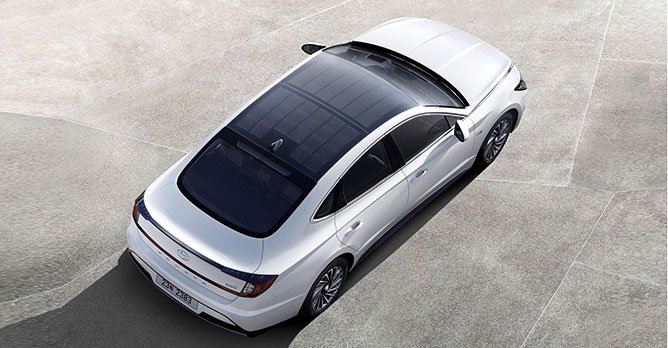Hyundai launches first solar roof charging system for the Sonata Hybrid
07 Aug 2019|4,649 views
Hyundai Motor is launching its first car with a solar roof charging system. This groundbreaking eco-friendly technology will provide vehicles with additional electrical power, as well as increasing fuel efficiency and driving range.

In the coming years, Hyundai will roll out the technology to other vehicles across its range. This is the latest application of a smart solution from Hyundai advancing the mobility industry towards a more sustainable future.
The solar roof system includes a structure of silicon solar panels that are mounted on the car's roof. Being able to charge even while driving, the solar roof system can charge 30% to 60% of the battery per day and with six hours of daily charging, it is expected to increase travel distance by an extra 1,300km annually.
The system is composed of a solar panel and a controller. Electricity is produced when solar energy activates the solar panel's surface, which converts this energy by using photons of light from the sun. This creates the electron-hole pairs in silicon cells, which generate solar electricity.
The electricity from this process is converted to the standard voltage by the controller, then stored in the battery. Hyundai Motor took not only efficiency but also design into account while developing the solar charging system.
While the solar roof system currently plays a supporting role, it opens up perspectives for vehicles that no longer need fossil fuel to operate.
Hyundai Motor is launching its first car with a solar roof charging system. This groundbreaking eco-friendly technology will provide vehicles with additional electrical power, as well as increasing fuel efficiency and driving range.

In the coming years, Hyundai will roll out the technology to other vehicles across its range. This is the latest application of a smart solution from Hyundai advancing the mobility industry towards a more sustainable future.
The solar roof system includes a structure of silicon solar panels that are mounted on the car's roof. Being able to charge even while driving, the solar roof system can charge 30% to 60% of the battery per day and with six hours of daily charging, it is expected to increase travel distance by an extra 1,300km annually.
The system is composed of a solar panel and a controller. Electricity is produced when solar energy activates the solar panel's surface, which converts this energy by using photons of light from the sun. This creates the electron-hole pairs in silicon cells, which generate solar electricity.
The electricity from this process is converted to the standard voltage by the controller, then stored in the battery. Hyundai Motor took not only efficiency but also design into account while developing the solar charging system.
While the solar roof system currently plays a supporting role, it opens up perspectives for vehicles that no longer need fossil fuel to operate.
Latest COE Prices
December 2025 | 1st BIDDING
NEXT TENDER: 17 Dec 2025
CAT A$105,413
CAT B$123,900
CAT C$76,501
CAT E$123,000
View Full Results Thank You For Your Subscription.


















